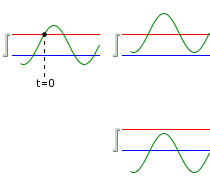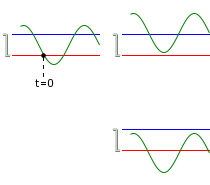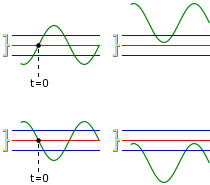Edge trigger can be used to trigger on a Rising edge (or slope), a Falling edge or Any edge in the signal. Which edge is being triggered on, can be selected.
To trigger on a rising or falling edge, the system uses two adjustable levels. One level is called the arming level and the other the firing level. Triggering on any edge uses three levels, one firing level and two arming levels. The trigger system will constantly compare the input signal with these levels.
In order to generate a trigger, the signal must pass two levels, first an arming level and then the firing level, both in the same direction. When the input signal passes an arming level in the specified direction, the trigger system gets "armed". When the input signal passes the firing level in the specified direction and the trigger system is armed, the required edge is found, the trigger condition is met and a trigger signal is generated ("fired"). When the input signal passes the firing level but the trigger system is not armed, nothing happens and the system will continue monitoring the input signals.
The firing level is controlled by the trigger level. The distance of the arming level(s) to the trigger level is controlled by the trigger hysteresis. When triggering on any edge, the software will place them symmetrically around the firing level.
Rising edge
When triggering on a Rising edge, the signal must cross the arming level (blue) and the firing level (red) in an upward direction.
When one of the levels is not crossed, no trigger occurs.

Falling edge
When triggering on a Falling edge, the signal must cross the arming level (blue) and the firing level (red) in an downward direction.
When one of the levels is not crossed, no trigger occurs.

Any edge
When triggering on a Any edge, the signal must cross one of the arming levels (blue) and the firing level (red) both in the same direction.
When no arming level or no firing level is crossed, no trigger occurs.

